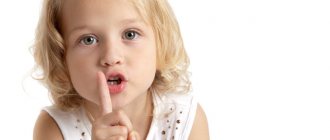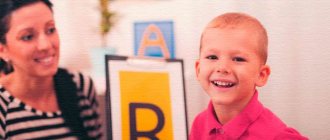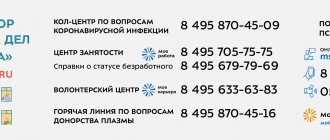Younger preschoolers have unique characteristics in the development of speech: their psyche is especially sensitive to language, to its semantic and sound aspects. Language enrichment occurs as a result of performing new tasks that arise during communication and during one’s own activities. All this creates the prerequisites for the further formation of speech.
Speech development in younger preschoolers
The purposeful development of speech in younger preschoolers is one of the leading areas of pedagogical activity, ensuring the timely mental development of children. Speech is the basis of the human mind, the crown of nature’s creation; from early childhood, human life is connected with language.
In the development of a child’s speech, the leading role is played by adults: the family (parents) and the kindergarten teacher. The child’s success in mastering the language depends on the culture of speech of adults and how they talk to the child, how much time they devote to verbal communication.
Thus, an adult’s speech must comply with the norms of literary language and literary colloquial speech both in terms of the sound aspect (diction, tempo, pronunciation of sounds and words) and in terms of the richness of the vocabulary, accuracy of word use, grammatical correctness and coherence.
The main goal of speech development of young children:
- formation of oral speech and verbal communication skills
- Main tasks of speech development:
- formation of a dictionary
- development of sound culture of speech
- development of grammatical structure of speech
- development of coherent speech
- introducing children to fiction.
When developing speech, you need to take care not only that the child pronounces as many words as possible, but also that the heard and spoken words are supported by living images and specific content. And to do this, you need to not only talk with the child about this or that, but also introduce him to the real world of things, phenomena, events. It is necessary that he sees what they are talking about with his own eyes, hears with his own ears and, if possible, acts with his own hands. During this period, the baby is especially interested in the names of objects and phenomena, and every now and then he asks adults the question: “What is this”? Take advantage of this favorable moment, communicate more with your child, thus accumulating his passive vocabulary.
You can and should talk to a 2-3 year old child about things that are not currently in his field of vision, for example, what he saw this morning on a walk or even some time ago. This develops his speech, trains his memory, teaches him to listen to other people’s speech and understand it.
More often, look at various pictures with a plot that he understands with your child, discuss them, and come up with short stories. In this case, the adult must give the child a sample of correct speech.
If a child pronounces any sounds or words incorrectly, you should not laugh or imitate him. You cannot scold your child for poor speech and demand that he immediately and correctly repeat a word that is difficult for him. This will lead to the child trying not to use some words at all or replacing them with others. Do not imitate your child by repeating words he pronounces incorrectly. And there is no need to try to point out to the child that this is wrong. It is better to repeat the word after the baby, but pronounce it clearly so that all sounds can be heard.
Speech development in children 3-4 years old occurs especially quickly. As a rule, by the age of 3, a child almost masters his native language. The active vocabulary of children from 3 to 4 years old grows literally by leaps and bounds, up to about 100 new words per month. If at three years old a child needs a few hundred words to communicate, at four years old this figure reaches 1.5-2 thousand words. At the same time, we must remember that in a family, adults use an average of 3 to 5 thousand words for everyday communication.
The sound design of words also improves quickly, and phrases become more developed. However, not all children have the same level of speech development: some pronounce words clearly and correctly by the age of three; others do not speak clearly enough, pronounce words incorrectly; Still others speak insufficiently clearly and pronounce certain sounds incorrectly. The most typical mistakes are omission and replacement of sounds, rearrangement of sounds and syllables, violation of the syllabic structure (abbreviation of words - “tamva”, instead of tram, incorrect stress).
The speech of three-year-olds is the same. They pronounce all verbs in the present tense. The baby's understanding of the past or future is still limited. The sentences are similar to each other: the subject comes first, then the predicate, then the object. Kids easily perceive simple nominal sentences. At this age, children develop a special interest in words. Kids try to establish the meaning of words, their origin, create their own words (a mug instead of a spring). The baby is attracted by the sound design of words, and he even tries to correct poorly speaking peers, although he still cannot determine which sound or often the word is pronounced incorrectly.
The child cannot yet independently determine what sounds a word consists of, establish their sequence, or decompose the word into parts (syllable sounds).
The main directions of work on speech development in the second junior group are as follows:
Expanding children's vocabulary
Development of sound culture of speech
Development of grammatical structure of speech
Development of coherent speech (monologue and dialogic)
Development of figurative speech
The main forms are the organization of educational situations and communication situations. Teachers organize educational situations - looking at pictures, toys, reading fairy tales and short stories, learning poems. Their goal is to teach children the ability to compose stories, tell fairy tales and act out them, the ability to ask questions and retell heard content, and compose their own story based on the listened content. We organize this educational situation at any time of the day - in the morning, in the evening, during a walk with one or more children. We repeat one situation several times with different children. Communication situations most often arise spontaneously, and teachers see and support such situations. They try to grasp the meaning of the child’s statement, which often consists of one or two short phrases, and with their questions encourage the child to engage in dialogue or a more complete statement.
An important role in the development of a child’s speech belongs to the artistic word. Kids love poetry very much. They are pleased with the rhythm of the verse, they enrich children's experiences, develop thinking, and awaken a love for the literary word and their native language.
Poems, nursery rhymes, jokes, accompanied by playful activities, delight children.
Kids need to read short poems, simple ones, with images that are understandable to the child (poems by A. Barto from the “Toys” series). They have access to the simplest fairy tales - “Ryaba the Hen”, “Turnip”, “Teremok”, “Kolobok”. Children of this age perceive vividly, quickly remember and begin to repeat what they like.
More opportunities for speech development open up while walking with your child. Bright summer sun or fluffy snowflakes - all this attracts a child and can serve as a topic for conversation with him.
When looking at pictures in books and magazines, name and explain to your child everything that he sees in front of him. Repeat the desired word several times, ask to see the object you named, and then ask him to name the word himself. Be sure to praise your baby and celebrate his successes.
Draw your child’s attention more often in everyday life to the colors of objects, ask leading questions: “What color is your blouse? What about the boots? When your child draws, be sure to highlight with a pencil what color he is drawing.
There is a close connection between speech development and the development of gross and fine motor skills. Therefore, we recommend that you constantly use fine motor skills games when communicating with your child - stringing beads and buttons on wire, using finger games, finger painting, sculpting from plasticine, salt dough, clay. Games with cereals, with shells of seeds, nuts, large fruit seeds. Try putting together large puzzles and describing the picture that will come out.
Features of speech development at 3-4 years old
Thanks to speech, the child begins his acquaintance with the world around him. Every year this acquaintance becomes more intense and fulfilling. It is important that the speech development of preschool children occurs in a timely manner, in accordance with the norms that can be traced at a certain age level.
At 3 years of age, the anatomical maturation of the speech areas of the brain is largely completed. A three-year-old child is able to perceive many concepts if they are explained clearly to him. Gradually, a valuable base is accumulated, which a child of 3 years should be able to do.
Motor speech is gaining momentum. Most of the words are still pronounced by the baby in his own language, understandable only to those close to him. But the child already talks a lot. Adults need to understand the process of child speech formation in order to effectively influence it.
At this age, new words are easier and more firmly assimilated if they are accompanied by motor conditioned reflexes.
If you just show a child a new object and name it, a 3-year-old baby will immediately forget its name. In order for a new concept to take hold, it is extremely important to connect as many sensory organs as possible. For example: “Look, this is a bell. He knows how to make calls. Listen to how it sounds. Now you ring the bell. Let's call softly, and now loudly. Do you remember what it's called? Say "kol-kol-chick."
After such a thorough acquaintance, a new word will be deposited in the child’s memory. Moreover, the child will at the same time learn the grammatical standards of his native language and understand how to include a new word in sentences (bell, bell, etc.).
It should be remembered that children at 3-4 years old do not understand all the words that their elders address to them. Moreover, they do not have access to the figurative meaning of phrases, which are often abused by adults. As usual, parents, trying to accustom their child to order, give instructions of this kind: “Put your toys neatly.” And they are surprised that they see a result that is not at all what they expected.
There are objective reasons for this. Firstly, a child may not classify everything he plays with as a generalized concept of a toy. Therefore, he can put all kinds of bears and dolls in their places, but he won’t even touch the cars. Secondly, the condition is neat and completely incomprehensible to a three-year-old mind in this context. The baby understands what they want from him when they encourage him to eat carefully, and he already knows that it is important to keep his clothes clean while eating. But what does this have to do with folding toys?.. Of course, the baby is not capable of such reasoning. He simply does not apply the condition of neatness when collecting toys.
Norms of speech development at 3-4 years
Parents compare the achievements of their child and other children. Even if one tries not to resort to this, comparison occurs involuntarily. It is natural for caring parents to want to know what achievements are possible at the age of 3.
Of course, there are average standards regarding the development of children's speech. You can only be guided by them approximately, because at the age of three the child is still too small to fit into any framework.
Basically, the speech of preschoolers 3-4 years old is characterized by the following parameters:
- Vocabulary 1500-1900 words;
- Speaks in simple sentences;
- Speech is situational (“Give me that”, “My car is there”, etc.);
- Uses mainly nouns, verbs and pronouns;
- The pronunciation is expressed softened, with distortion of many sounds.
Speech disorders at this age are natural. The main thing is that adults should not adapt to children's language. By the way, preschoolers really don’t like it when adults distort words, imitating children’s pronunciation.
How to develop a child's speech at 3 years old
It is obvious that the baby needs help to fully master speech. Let's consider some available ways and methods for developing speech skills in early preschool age.
Our speech is characterized by numerous associative connections. This should be used to help the preschooler learn more words and more actively include them in his statements.
Linguists explain that every concept necessarily has a set of words associated with it, and this set is called an associative field. Parents can effectively help preschoolers assign such fields. If your child notices a cat or dog, ask him what kind of cat or dog he is. Even a three-year-old will search for words to describe them. If a child takes an apple, ask what kind of apple it is.
There are many associative connections in fairy tales. Stories that are easy to understand for children contain interesting and easy-to-remember phrases. After listening to fairy tales, younger preschoolers repeat: “the egg is not simple, but golden”, “once upon a time”, “bun-bun, I will eat you” and similar stable expressions. Fairy tales contain enormous potential for the development of children's speech (Possibilities of fairy tales).
It is useful to use finger games for children. Physiologists have convincingly proven that the level of speech development in children depends on the degree of development of fine motor skills.
What toys, books and aids can be used for speech development
To help parents, there are special benefits that will accelerate the baby’s speech development. Most often these are cards with pictures. It is very useful to accompany classes with images of objects. Looking at the card, the child will first name what is shown on it. Then you can come up with a short story together about this animal or object.
Children are developed by blocks, puzzles, toys, construction sets, including Lego. You need to start with 3-4 parts, increasing their number with age. Toys are always included in educational games. The most convenient object is a ball. The favorite children's game - "Edible - inedible" is impossible without this item. Let your child catch the ball when you say something is edible, and return it when you say the opposite.
Other ball games:
- Mom throws the ball and names the letter. The child catches it, comes up with a word starting with the named letter, pronounces it and throws the ball to his mother.
- With older children, try playing antonyms. Mom throws the ball and says a word, and the child comes up with the opposite: day - night, light - shadow, fast - slow, black - white, etc.
Listening to sounds should be included in your classes. It’s good if you have the opportunity to take your child to the zoo.
Useful books for speech development:
- E. Yanushko “Speech development in children 1-3 years old.”
- S. Batyaeva, E. Savostyanova “Album on speech development for the little ones.”
- L. Smirnova “Speech development in children 2-3 years old.”
- A. Astakhov “My first book.”
- O. Zhukova “Baby’s first textbook.”
- All books with folk tales and pictures, alphabet.







